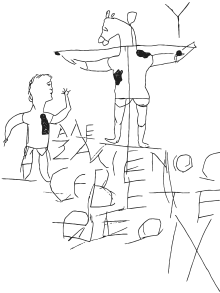This Anti-Christian Graffito May Be Earliest Depiction of Crucifixion
We are mocked in popular culture. We are attacked by the government. But this, as we know, is nothing new for Christians.
In fact, it's rather fitting that perhaps the earliest surviving depiction of Christ crucified might just be anti-Christian graffiti. Discovered in 1857, carved into a wall near the Palatine Hill in Rome, the graffiti is believed to have been drawn around 200 AD. The central figure of the drawing is a crucified figure with the body of a man and the head of a donkey or ass. To the left of the crucified figure is a man raising his hand in presumed worship. A mocking inscription accompanies the drawing which says "Alexamenos worshipping his God."
The donkey head must have been a prevalent slander at the time as, Tertullian, a convert, countered the accusation in his writings:
"…you have dreamed that our God is an ass’s head. This sort of notion Cornelius Tacitus introduced. [2] For in the fifth book of his Histories [5.4] he begins his account of the Jewish War with the origin of the race; and about that origin as about the name and religion of the race he discoursed as he pleased. He tells how the Jews, liberated from Egypt, or, as he thought, exiled, were in the wilderness of Arabia utterly barren of water; and how, dying of thirst, they saw wild asses, which chanced to be returning from their pasture (it was thought) to slake their thirst; how they used them as guides to a fountain, and out of gratitude consecrated the likeness of a beast of the kind. [3] Thence came, I think, the assumption that we too, standing so near Jewish religion, are devoted to worship of the same image." Tertullian, Apology. 16: 1-3
Arrows of derision have been targeting Christians since the beginning. It doesn't make them hurt less to know that they've been flown at us for 2,000 years. But we also know it is our response to it that matters.
We are called to love those who mock us, deride us. We are called to continually persevere in loving God, even at the cost of the world's view of us. We have countless examples of love and faith overcoming derision and violence throughout the millennia from Stephen the Martyr to Maximillian Kolbe and countless others.
And yes, it would seem we even have the example of Alexamenos too. In a lesser known scribbling on an interior wall dated around the same time, there was written what seems like a response to the blasphemous message. It reads "Alex is faithful."













